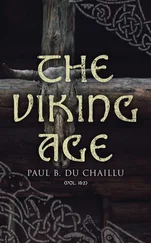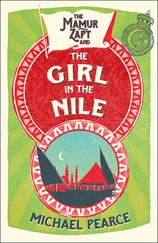II: How they planned a christening feast for King Harald’s grandson
III: Concerning the strangers that came with salt, and how King Sven lost a head
IV: How Orm preached to the salt-pedlar
V: Concerning the great christening feast, and how the first Smalanders came to be baptized
VI: Concerning four strange beggars, and how the Erin Masters came to Father Willibald’s assistance
VII: Concerning the King of Sweden’s sword-bearer, and the magister from Aachen and his sins
VIII: Concerning the sinful magister’s second sin, and the penance to which he was condemned for it
IX: How the magister searched for heifers and sat in a cherry-tree
X: Concerning the women’s doings at the Kraka Stone, and how Blue-Tongue’s edge became dented
XI: Concerning Toke Grey-Gullsson, and a misfortune that befell him; and of a foul gift Orm received from the Finnvedings
XII: Concerning the Thing at the Kraka Stone
PART FOUR: THE BULGAR GOLD
I: Concerning the end of the world, and how Orm’s children grew up
II: Concerning the man from the East
III: Concerning the story of the Bulgar gold
IV: How they planned to get the gold
V: How they sailed to the Gotland Vi
VI: How they rowed to the Dnieper
VII: Concerning what happened at the weirs
VIII: How Orm met an old friend
IX: Concerning their journey home, and how Olof Summer-Bird vowed to become a Christian
X: How they settled accounts with the crazy magister
XI: Concerning the great hounds’ chase
Footnotes
About the Author
About the Publisher
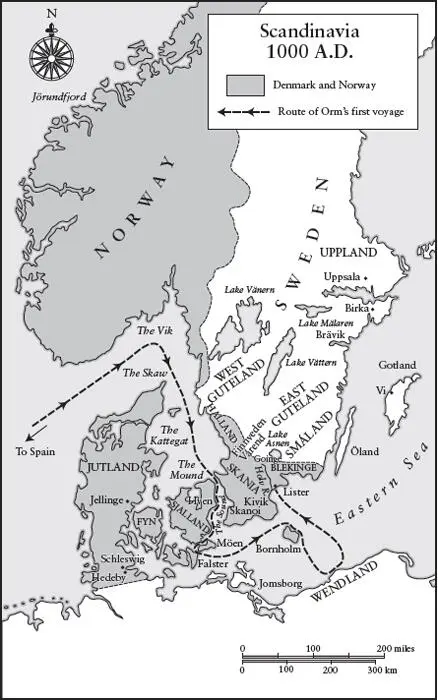
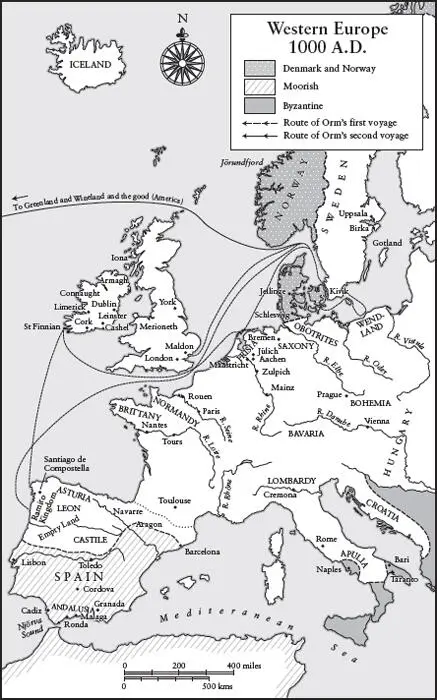
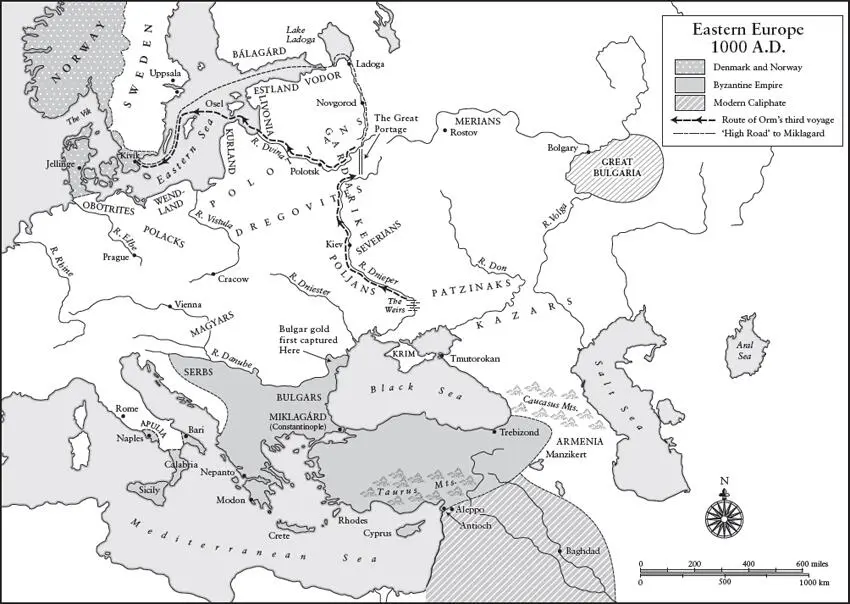
The action of The Long Ships covers, approximately, the years A.D. 980–1010. At that time, the southern provinces of Sweden belonged to Denmark, so that Orm, although born and bred in Skania, regarded himself as a Dane. 1
The Vikings harried the countries of northern and western Europe more or less continuously for a period of over 200 years, from the end of the eighth century until the beginning of the eleventh. Most of the raids on western Europe were carried out by Danes and Norwegians; for the Swedes regarded the Baltic as their domain, and founded a kingdom in Russia at the end of the ninth century which endured for 350 years, until the coming of the Mongols. Ireland was, at first, the favourite western hunting-ground of the Vikings; it was not until 838, forty years after the first attack on Ireland, that they began to raid England in large numbers. For the next sixty years, however, they – especially the great Ragnar Hairy-Breeks and his terrible sons – troubled England cruelly, until Alfred withstood them and forced them to come to terms. Then, from 896 until 979, England enjoyed eighty years of almost unbroken respite from their fury. In France, the Northmen were so feared that, in 911, Charles the Simple ceded part of his kingdom to them; this came to be known as Normandy, the Northmen’s land. Vikings peopled Iceland in 860, and Greenland in 986. In the latter year a Viking ship heading for Greenland went off its course and reached America, which, because of the good grapes they found there, the men named ‘Wineland the Good.’ Several other Viking ships sailed to America during the next twenty years.
The Battle of Jörundfjord, or Hjörungavag, so frequently referred to in the following pages, was one of the most famous battles fought in the north during the Viking Age. It was fought between the Norwegians and the Jomsvikings. The Jomsvikings (to quote Professor C. Turville-Petre) were ‘a closed society of Vikings, living according to their own laws and customs. None of them might be younger than eighteen years, and none older than fifty; they must not quarrel among themselves, and each must avenge the other as his brother.’ No woman was allowed within their citadel, Jomsborg, which was sited on the southern shore of the Baltic, probably in the region of where Swinemunde now stands. According to Icelandic sources, Canute’s father, King Sven Forkbeard, invited the Jomsvikings to a feast. As the ale flowed, King Sven swore an oath to invade England and kill Ethelred the Unready, or else drive him into exile. The Jomsviking chieftain, Sigvalde, swore in his turn to sail to Norway and kill the rebel Jarl Haakon, or else drive him into exile. All the other Jomsvikings, including the two Skanian chieftains, Bue Digre and Vagn Akesson, swore to follow him. They sailed to Norway with sixty ships, but Haakon got wind of their approach and, when at last they turned into Jörundfjord, they found him waiting for them with a fleet of no less than 180 ships. At first, despite being thus outnumbered, the Jomsvikings looked likely to prevail; but the weather turned against them and, after a bitter struggle, they were routed and slaughtered almost to a man.
This was in 989. In the following spring, another vital battle was fought in Sweden, on Fyris Plain before Uppsala, when the dreaded Styrbjörn, the exiled nephew of King Erik of Sweden, sought to win his uncle’s kingdom, but was killed by a chance spear in the first moments of the fight. It is to the echoes of these two battles that The Long Ships opens.
M.M.
PROLOGUE
How the shaven men fared in Skania in King Harald Bluetooth’s time
Many restless men rowed north from Skania with Blue and Vagn, and found ill fortune at Jörundfjord; others marched with Styrbjörn to Uppsala and died there with him. When the news reached their homeland that few of them could be expected to return, elegies were declaimed and memorial stones set up; whereupon, all sensible men agreed that what had happened was for the best, since they could now hope to have a more peaceful time than before, and less parcelling out of land by the axe and sword. There followed a time of plenty, with fine rye harvests and great herring catches, so that most people were well contented; but there were some who thought that the crops were tardy, and they went a-viking in Ireland and England, where fortune smiled on their wars; and many of them stayed there.
About this time the shaven men had begun to arrive in Skania both from the Saxons’ land and from England, to preach the Christian faith. They had many strange tales to relate, and at first people were curious and listened to them eagerly, and women found it pleasant to be baptized by these foreigners, and to be presented with a white shift. Before long, however, the foreigners began to run short of shifts, and people wearied of their sermons, finding them tedious and their matter doubtful; besides which, they spoke a rough-sounding dialect that they had learned in Hedeby or in the western islands, which gave their speech a foolish air.
So then there was something of a decline in conversions, and the shaven men, who talked incessantly of peace and were above all very violent in their denunciation of the gods, were one by one seized by devout persons and were hung up on sacred ash-trees and shot at with arrows, and offered to the birds of Odin. Others went northwards to the forests of the Göings, where men were less religiously inclined; there, they were welcomed warmly, and were tied up and led to the markets in Smaland, where they were bartered for oxen and for beaver skins. Some of them, upon finding themselves slaves of the Smalanders, let their hair grow and waxed discontented with their God Jehovah, and gave good service to their masters; but the majority continued to denounce the gods and to spend their time baptizing women and children instead of breaking stones and grinding corn, and made such annoyance of themselves that soon it became impossible for the Göings to obtain, as hitherto, a yoke of three-year-old oxen for a sturdy priest without giving a measure of salt or cloth into the bargain. So feeling increased against the shaven men in the border country.
Читать дальше







